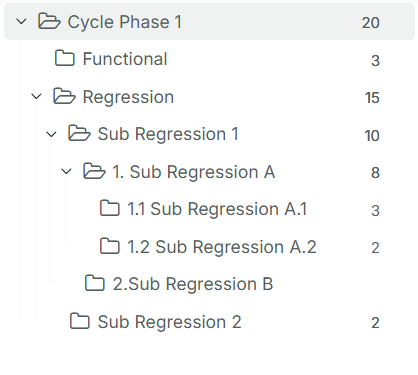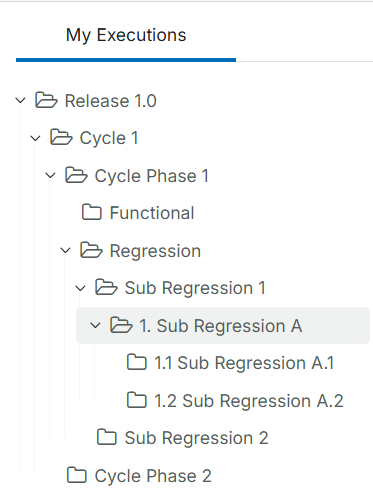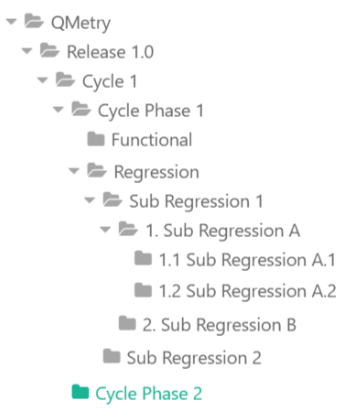Test Planning and Execution Module Migration
Migration of the Test Planning and Execution Approach
The Zephyr Enterprise releases are created as a parent folder in the QMetry Test Suite Module.
Zephyr Enterprise Cycles in the Test Plan are mapped as subfolders under the corresponding parent release folders in QMetry. If a cycle is marked as hidden, it appears as an archived Test Suite folder in QMetry.
Zephyr Enterprise phases are organized under Cycles in the Test Plan, and are mapped as sub-folders under the respective parent Cycle folders in QMetry.
A Zephyr Enterprise cycle's start and end dates are mapped to the corresponding start and end date fields in the Test Suite.
In QMetry, Test Suites are mapped to the phase name, and suites are created only for phases that contain test cases.
In QMetry Test Suite, the cycles and cycle phases from Zephyr Enterprise are linked to “No Platform” in QMetry if no environment information is available. They are always created as folders regardless of whether they contain any test cases.
The environment fields from Zephyr Enterprise are migrated as Platforms in QMetry. If no environment information is available, the tests are linked to “No Platform” in QMetry.
The build field from ZE is migrated to builds in QMetry.. If no build is found, the test case execution is recorded with an empty build in QMetry.
Example
Following is an example of the folder structure for Test Planning after migration.

Following is an example of the folder structure for Test execution after migration.

Following is an example of the folder structure for the Test Suite after migration.

User and Test Case Assignee Migration
QMetry migrates test case executions assigned to the “Anyone” user in Zephyr Enterprise based on the following rules:
If the test case has been executed, the system assigns it to the “Executed by” user.
If the test case is not executed, the system keeps the assignee as “Unassigned.”
Note
Unassigned test cases under a test plan in Zephyr Enterprise are not migrated to QMetry in the test suite.
Test case includes a call-to-test and is parameterized. The following approach is considered:
If the test case execution is marked as Passed, all steps in the test case are marked as Passed.
If a test case execution is marked as "Failed," "Blocked," or with any status other than "Passed," all steps in the test case are marked as "Not Run." The overall status of the test case appears to be the same as that of Zephyr Enterprise.
Test Case Execution Status Mapping
Zephyr Enterprise defines execution statuses at the instance level, while QMetry defines them at the project level. This allows QA teams to create execution workflows tailored to each project.
Zephyr defines separate execution statuses for test steps. QMetry uses the same definitions of execution statuses for test cases and steps.
The following table provides the key differences between QMetry and Zephyr Enterprise mapping:
Zephyr Enterprise | QMetry | Mapping Details |
|---|---|---|
Unexecuted | Not Run | Both indicate the test has not yet been executed. |
Pass | Passed | Both indicate a successful execution. |
Fail | Failed | Both indicate unsuccessful execution. |
WIP | Work in Progress (WIP) | Zephyr tracks “Work In Progress” as a distinct status. QMetry typically tracks ongoing executions as “Not Run” until completion. |
Blocked | Blocked | Both indicated a blocked execution. |
Custom Status | Custom Status | QMetry creates a custom status for each custom test case or test step status from Zephyr Enterprise. |
Test Case Execution Priority Order
Following is the test case execution priority order:
Zephyr Enterprise
Fail → Blocked → Others
QMetry
Blocked → Failed → Passed → others